How Much Should a Family of 3 Give to a Second Wedding
A hymeneals is a ceremony where two people are united in marriage. Wedding traditions and customs vary profoundly betwixt cultures, ethnic groups, religions, countries, and social classes. Most wedding ceremonies involve an exchange of marriage vows by a couple, presentation of a gift (offering, rings, symbolic item, flowers, money, apparel), and a public announcement of wedlock past an authority figure or celebrant. Special wedding garments are oft worn, and the ceremony is sometimes followed by a wedding reception. Music, poesy, prayers, or readings from religious texts or literature are also commonly incorporated into the anniversary, too as superstitious community.
Common elements across cultures [edit]


Some cultures take adopted the traditional Western custom of the white wedding, in which a bride wears a white nuptials dress and veil. This tradition was popularized through the marriage of Queen Victoria.[one] Some say Victoria'south choice of a white gown may accept just been a sign of extravagance, but may accept as well been influenced past the values she held which emphasized sexual purity.[2]
The apply of a wedding band has long been part of religious weddings in Europe and America, only the origin of the tradition is unclear. Ane possibility is the Roman belief in the Vena amoris, which was believed to be a blood vessel that ran from the fourth finger (band finger) directly to the heart. Thus, when a couple wore rings on this finger, their hearts were connected. Historian Vicki Howard points out that the belief in the "aboriginal" quality of the practice is most likely a modern invention.[3] In the U.s.a. of America, a groom'due south wedding band has not appeared until the early 20th century,[iv] while in Europe it has been role of the tradition since the ancient Romans, as witnessed by the jurist Gaius.
The leave from the wedding is also called the "transport off", and often includes traditional practices, such equally the newlyweds and the wedding political party bowing and kissing the knees of the elders in Ethiopian weddings. The ship off oft includes throwing rice (a symbol of prosperity and fertility)[5] or other seeds at the newlyweds in near of the Western earth,[6] equally well every bit for example Bharat[5] and Malaysia.[seven] Despite fears of the opposite, the apply of uncooked rice for this purpose is not harmful to birds.[eight] Shoe tossing in place of rice has likewise been used in several cultures.[9]

The wedding ceremony ceremony is ofttimes followed by wedding reception or a wedding breakfast, in which the rituals may include speeches from a groom, best man, father of a bride and mayhap a bride,[10] the newlyweds' first trip the light fantastic as a couple, and the cutting of an elegant wedding cake. In recent years traditions have changed to include a father-daughter dance for a bride and her father, and sometimes also a mother-son dance for a groom and his mother.
Traditional wedding attire [edit]
- Western dress code
- Wedding dress (or bridal gown), a special dress worn by a helpmate.
- Wedding veil, popularized by Queen Victoria, was a long-held custom in which the 'purity' and 'innocence' of the helpmate could thwart away evil spirits.
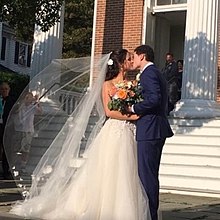
Traditional western wedding veil
- Morning dress, western daytime formal dress
- White tie ("evening wearing apparel" in the U.Thou; very formal evening attire)
- Blackness tie or Evening Arrange ("dinner jacket" in the U.Thousand; often referred to as a "tuxedo" in the U.S; traditionally appropriate only for use later 6:00 p.1000.
- Stroller
- Lounge suit
- Not-traditional "tuxedo" variants (colored jackets/ties, "hymeneals suits")
- Ao dai, traditional garments of Vietnam
- Barong Tagalog, an embroidered, formal men's garment of the Philippines
- Batik and Kebaya, a garment worn by the Javanese people of Indonesia and also by the Malay people of Malaysia
- Dashiki, the traditional West African hymeneals attire
- Dhoti, male garment in S India
- Hanbok, the traditional garment of Korea
- Kilt, male person garment particular to Scottish culture[11] [12] [thirteen]
- Kittel, a white robe worn by the groom at an Orthodox Jewish wedding. The kittel is worn but under the chuppah, and is removed before the reception.
- Qun Gua or Kua (裙褂 pinyin qún guà, Cantonese kwàhn kwáa), Chinese traditional formal habiliment. This can exist in the form of a qipao or hanfu.
- Ribbon shirt, oftentimes worn by American Indian men on cheering occasions, such equally weddings, another common custom is to wrap helpmate and groom in a blanket
- Sampot, traditional clothes in Kingdom of cambodia
- Sari/Lehenga, Indian popular and traditional dress in India
- Seshweshe, a female dress worn by the Basotho women during special ceremonies. Although it has recently been adopted to men attire also.
- Sherwani, a long coat-like garment worn in Southern asia
- Shiromuku Kimono, a traditional wedding garment in Japan
- Tiara, or hymeneals crown, worn by Syrian and Greek couples (which are chosen "τα στέφανα," which literally means "wreaths") and Scandinavian brides
- Topor, a type of conical headgear traditionally worn by grooms as part of the Bengali Hindu wedding ceremony
- Different nuptials clothing around the globe
-
Khmer (Cambodian) wedding in traditional outfits
-
A bride and a bridegroom in Nepal
-

-
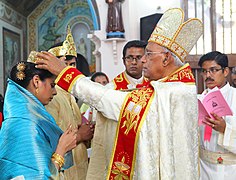
-

Japanese helpmate and bridegroom
-

-

-

-

Wedding 1935 in Barcelona, Spain
-

-

-

Groom in the traditional dress of People's republic of bangladesh in a wedding ceremony.
-

Armenian Wedding at Khor Virap
-
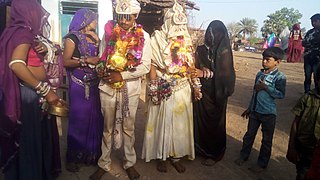
Aadiwasi tribal marriage groom bride, India
Wedding music [edit]
Western weddings [edit]
Music played at Western weddings includes a processional song for walking down the aisle (ex: wedding ceremony march) either before or subsequently the marriage service. An example of such utilise is reported in the wedding of Nora Robinson and Alexander Kirkman Finlay in 1878.[14]
The "Bridal Chorus" from Lohengrin by Richard Wagner, ordinarily known as "Here Comes the Helpmate", is often used every bit the processional. Wagner is said to take been anti-Semitic,[15] and as a result, the Bridal Chorus is normally not used at Jewish weddings.[16] United kingdom police force forbids music with any religious connotations to be used in a ceremonious ceremony.[17]
Johann Pachelbel's Canon in D is an culling processional.[xviii] Other alternatives include various contemporary melodies, such as Bob Marley's One Love, which is sometimes performed past a steel drum band.[4] The Music used in modern weddings is left completely up to the Bride and Groom and it is also becoming growingly popular for couples to add together their own twist to the song they walk down the aisle to. Many Brides and Grooms use songs that are sentimental or hold special value to them.
In the The states, approximately ii million people go married each year and shut to 70 million people attend a nuptials and spend more than $100 on a gift.[xix]
In the United Kingdom, according to a survey, the average spend minimum spend on a wedding gift is £24.70 and the boilerplate maximum spend is £111.46. 85% of people said that they were more than likely to spend more coin on a person if they had a improve human relationship with them.
Religious aspects [edit]
| | This section may demand to be rewritten to comply with Wikipedia's quality standards, equally the intro to this section is about marriage and needs to be rewritten to discuss wedding ceremonies and traditions instead, as does the section on Christian community. A large amount of info in the section on Jewish community is commented out and needs to be incorporated. Sections on other religious customs such as Islamic and Shinto weddings would also exist helpful. (May 2009) |
Most religions recognize a lifelong union with established ceremonies and rituals. Some religions permit polygamous marriages or same-sex marriages.
Many Christian faiths emphasize the raising of children as a priority in a marriage. In Judaism, marriage is so important that remaining unmarried is deemed unnatural.[ citation needed ] Islam also recommends marriage highly; among other things, it helps in the pursuit of spiritual perfection.[ citation needed ] The Baháʼí Faith believes that marriage is a foundation of the construction of society, and considers it both a physical and spiritual bail that endures into the afterlife.[20] Hinduism sees wedlock as a sacred duty that entails both religious and social obligations.[ citation needed ] By contrast, Buddhism does not encourage or discourage union, although it does teach how one might live a happily married life and emphasizes that marital vows are non to be taken lightly.[ commendation needed ]
Different religions have different behavior regarding divorce and remarriage. In Christianity for instance, the Roman Cosmic Church and Allegheny Wesleyan Methodist Connection believe that matrimony is a sacrament and a valid union betwixt ii baptized persons cannot exist broken by whatsoever other means than death.[21] This ways that civil divorcés cannot remarry in a Catholic matrimony or Wesleyan Methodist marriage while their spouse is live.[21] In the surface area of nullity, religions and the land often apply different rules. A couple, for example, may brainstorm the process to take their marriage annulled by the Catholic Church merely subsequently they are no longer married in the optics of the civil potency.
Customs associated with various religions and cultures [edit]
Christian community [edit]

Most Christian churches give some form of blessing to a union, which is seen as a sacred institution in some sense, although terminology and associated theological meanings vary widely from one denomination to another: e.g., "holy matrimony," "sacrament of marriage," "holy ordinance of marriage," "holy union," and and so along.
A celebration of Holy Matrimony typically includes mutual vows or solemn promises of lifelong love and allegiance by the couple, and may include some sort of pledge by the community to support the couple'south relationship. A church wedding is a ceremony held in a church and presided over past a Christian pastor. Traditionally, Christian weddings occur in a church as Christian marriage ideally begins where one also starts their faith journey (Christians receive the sacrament of baptism in church in the presence of their congregation).[22] Catholic Christian weddings must "have place in a church building building" every bit holy wedlock is a sacrament; sacraments normatively occur in the presence of Christ in the firm of God, and "members of the faith community [should be] nowadays to witness the event and provide support and encouragement for those jubilant the sacrament."[22] Bishops never grant permission "to those requesting to be married in a garden, on the beach, or another place outside of the church" and a dispensation is but granted "in boggling circumstances (for instance, if a bride or groom is ill or disabled and unable to come up to the church)."[22] Marriage in the church building, for Christians, is seen as contributing to the fruit of the newlywed couple regularly attending church each Sun and raising children in the faith.[22]
Wedding ceremony ceremonies typically contain prayers and readings from the Holy Bible and reflect the church's teachings well-nigh the spiritual significance of wedlock, likewise every bit its purpose and obligations. The wedding service often includes the reception of Holy Communion, peculiarly in the context of Mass (every bit with Catholicism, Lutheranism, and Anglicanism).[23] In some traditional weddings of Western Christianity (specially Catholicism, Lutheranism and Anglicanism), a 'intendance cloth' or 'nuptial veil' (velatio nuptialis) "signifying a marriage yoke joining the helpmate and groom together" may be held over the kneeling couple during the nuptial blessing given by the priest.[24] [25] [26] [27] [28]
Pre-marital counseling may be urged or required for the engaged couple.[29] In some Christian countries or denominations, a betrothal rite, likewise every bit the reading of banns of wedlock may also exist required before the wedding engagement.[thirty]
In the Roman Cosmic Church, Holy Matrimony is considered to exist i of the vii sacraments, in this case, one that the spouses bequeath upon each other in forepart of a priest and members of the community equally witnesses. As with all sacraments, it is seen equally having been instituted by Jesus himself (run into Gospel of Matthew nineteen:1–2, Canon of the Catholic Church §1614–1615). In the Eastern Orthodox Church building, it is one of the Mysteries and is seen every bit an ordination and a martyrdom. The Christian nuptials ceremony of Saint Thomas Christians, an ethnoreligious grouping of Christians in Republic of india, incorporates elements from local Indian traditions. Protestant weddings may be elaborate (equally with Lutheranism and Anglicanism) or simple (as with Baptists). For instance, in the United Methodist Church, the Service of Christian Union (Rite I) includes the elements found in a typical Dominicus service, such as hymns, prayers, and readings from the Bible, as well as other elements unique to a wedding, including taking matrimony vows and an optional substitution of hymeneals rings, every bit well as a special benediction for the couple.[31] Holy Communion may exist role of the wedding service in liturgical Protestant churches (e.chiliad., Lutheran, Anglican, or Methodist), merely is rarely, if ever, found in weddings of other depression-church Protestant denominations (e.1000., Baptists).
A Quaker hymeneals ceremony in a Friends coming together is like to any other meeting for worship, and therefore often very different from the experience expected by not-Friends.[32]
In some Western countries, a separate and secular ceremonious wedding ceremony is required for recognition by the land, while in other Western countries, couples must merely obtain a spousal relationship license from a local regime authority and tin be married by Christian or other clergy authorized by law to do then.
Since the starting time of the 21st century, same-sex couples have been immune to marry civilly in many countries, and some Christian churches in those countries allow religious marriages of same-sex activity couples, though some forbid it. Run across the article Same-sex marriage.
Hindu customs [edit]
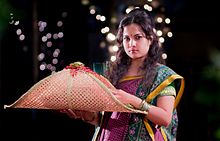
A girl with the traditional gift of Gaye holud.

Bridegroom arrives on horseback at a Rajput hymeneals
Hindu ceremonies are usually conducted totally or at to the lowest degree partially in Sanskrit, the linguistic communication of the Hindu scriptures. The wedding celebrations may last for several days and they can be extremely diverse, depending upon the region, denomination, and caste. Mehendi ceremony is a traditional ritual in Hindu weddings, where Henna application takes identify on the bride'southward hands and legs, before the wedding ceremony. On the wedding day, the bride and the bridegroom garland each other in front end of the guests. Most guests witness only this short anniversary and so socialize, have food, and leave. The religious part (if applicative) comes hours subsequently, witnessed past shut friends and relatives. In cases where a religious anniversary is present, a Brahmin (Hindu priest) arranges a sacred yajna (fire-sacrifice), and the sacred fire (Agni) is considered the prime witness (sākshī) of the marriage. He chants mantras from the Vedas and subsidiary texts while the couple is seated before the fire. The virtually important footstep is saptapadi or saat phere, wherein the bride and the groom, manus-in-paw, encircle the sacred fire 7 times, each circle representing a matrimonial vow. Then the groom marks the helpmate's hair departing with vermilion (sindoor) and puts a gold necklace (mangalsutra) around her neck. Or a yellow thread applied with turmeric is knotted around the bride's neck three times at marriage. The first knot represents her obedience and respect to her husband, the second i to his parents and the third represents her respect to God. Several other rituals may precede or follow these afore-mentioned rites. And so the bride formally departs from her blood-relatives to join the groom'south family unit.
Jewish customs [edit]
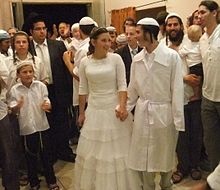
A traditional Jewish wedding usually follows this format:[33] [34] [35] [36] [37]
- Before the anniversary, the couple formalize a written ketubah (wedlock contract), specifying the obligations of husband to the wife and contingencies in example of divorce. The ketubah is signed by ii witnesses and later read under the chuppah (wedding canopy).
- The couple is married under the chuppah signifying their new home together. The chuppah can be made from a piece of cloth or other material attached to four poles, or a giant tallit (prayer shawl) held over the couple by iv family members or friends.
- The wedding couple is accompanied by both sets of parents and they join the wedding couple under the chuppah.
- In Orthodox Jewish weddings, the bride is accompanied to the chuppah by both mothers, and the groom is accompanied to the chuppah past both fathers.
- Vii blessings are recited, blessing the bride and groom and their new home.
- The couple sip a glass of vino from a Kiddush cup.
- The groom will smash a wine glass with his right foot, ostensibly in remembrance of the devastation of the Second Temple.
- In Reform Jewish weddings, the bride and groom tin can blast the wine glass together.
- At some weddings, the couple may declare that each is sanctified to the other, repeat other vows and commutation rings.
- In Orthodox Jewish weddings, the helpmate does not speak nether the chuppah and only she receives a ring. The groom recites "Harei at mekudeshet li thousand'dat Moshe 5'Yisrael"- "behold you are [thus] sanctified to me by the law of Moses and Israel" every bit he places the band on the bride's right index finger. The bride'due south silence and acceptance of the band signify her agreement to the marriage. This role of the ceremony is called kiddushin. The groom's giving an object of value to the bride is necessary for the wedding to exist valid.
- In more egalitarian weddings, the bride responds verbally, often giving the groom a ring in render. A common response is "ani l'dodi, v'dodi li" (I am my beloved's, my dearest is mine)
- In some Orthodox weddings, the groom then says:
- "If I forget you, O Jerusalem, may my right paw forget its skill.
- May my tongue cling to the roof of my mouth.
- If I practise non remember you,
- if I exercise non consider Jerusalem in my highest joy."
- The anniversary ends with the groom breaking a glass underfoot.
- The couple spend their first moments as husband and wife in seclusion (autonomously from the wedding ceremony guests, and with no other person present). This cheder yichud – "the room of seclusion (or 'oneness')" halachically strengthens the wedlock bond since Orthodox Jews are forbidden to exist secluded with an unrelated person of the reverse sex activity.
- The anniversary is followed by a seudat mitzvah, the wedding repast, too equally music and dancing.
- At the determination of the wedding meal, Birkat Hamazon (Grace Subsequently Meals) is recited, also as the seven wedding blessings.
In more observant communities, the couple will celebrate for 7 more days, chosen the Sheva Brachot (vii blessings) during which the vii wedding ceremony blessings are recited at every large gathering during this time.
Islamic community [edit]
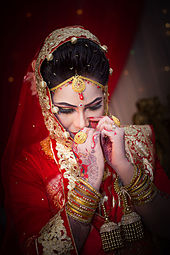

Henna on the hands of a bride in Tunisia
A wedding is typically a happy time for families to celebrate. In the Middle-e, at that place are colorful, cultural variations from place to identify.[38]
Two male witnesses who are the members of the family unit in most cases are required for Nikah. Co-ordinate to the Quran, in a married Muslim couple, both husband and wife act every bit each other's protector and comforter and therefore just meant "for each other".
All Muslim marriages have to exist declared publicly and are never to be undertaken in cloak-and-dagger. For many Muslims, it is the anniversary that counts as the actual wedding alongside a confirmation of that wedding in a registry office co-ordinate to fiqh. In Islam a nuptials is also viewed every bit a legal contract particularly in Islamic jurisprudences. However, most Muslim cultures carve up both the institutions of the mosque and marriage; no religious official is necessary, but very often an Imam presides and performs the anniversary, he may evangelize a curt sermon.[39] Celebrations may differ from country to state depending on their civilisation only the main anniversary is followed by a Walima (the spousal relationship feast).
In Islam, polygyny is allowed with certain religious restrictions. Despite that, an overwhelming bulk of Muslims traditionally exercise monogamy.
It is forbidden in Islam for parents or anyone else: to force, coerce, or trick either human being or woman into a marriage that is opposite to the individual will of whatever ane of the couples. It is besides necessary for all marriages to commence with the all-time of intentions.
Chinese customs [edit]
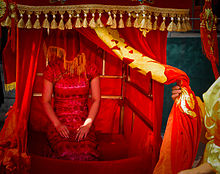
In traditional Chinese hymeneals ceremonies, helpmate arrives in a jiao
At traditional Chinese weddings, the tea ceremony is the equivalent of an exchange of vows at a Western wedding ceremony. This ritual is still practiced widely amongst rural Chinese; all the same, young people in larger cities, likewise as in Taiwan, Hong Kong, Malaysia, and Singapore, tend to practise a combination of Western fashion of marriage together with the tea ceremony.
When the bride leaves her dwelling house with the groom to his firm, a "Good Luck Adult female" volition hold a red umbrella over her head, meaning, "Raise the bark, spread the leaves." This "Good Luck Adult female" should exist someone who is blessed with a good marriage, salubrious children, and husband and living parents. Other relatives will besprinkle rice, ruddy beans, and greenish beans in front of her. The blood-red umbrella protects the bride from evil spirits, and the rice and beans are to attract the attending of the gold chicken.[twoscore]
The newlyweds kneel in front of parents presenting tea. A Adept Luck Adult female making the tea says auspicious phrases to bless the newlyweds and their families. The newlyweds too present tea to each other, raising the tea cups loftier to prove respect before presenting the tea to each other.
The attendants receiving the tea usually give the bride gifts such as jewelry or a red envelope.
The tea ceremony is an official ritual to introduce the newlyweds to each other's family, and a manner for newlyweds to show respect and appreciation to their parents. The newlyweds kneel in front of their parents, serving tea to both sides of parents, also as elder close relatives. Parents give their words of blessing and gifts to the newlyweds.
Humanist weddings [edit]
While many nuptials traditions and rituals accept origins in religions and are still performed by religious leaders, some marriage traditions are cultural and predate the prevalent religions in those regions. Non-religious people will frequently want to have a wedding ceremony that is secular (not religious) in content. In order to run into this demand, secular ceremonies by carried out past humanist celebrants get-go adult in the 19th century. Humanists UK members pioneered humanist weddings in the 1890s, and its weddings go along to be popular with couples across England, Wales, and Northern Ireland. In Scotland, Humanist Gild Scotland (HSS) has carried out secular ceremonies in the state since the 1980s. These take been legally recognised since 2005,[41] and became more numerous than church weddings in 2018.[42] [43]
Humanist wedding ceremonies are carried out in a diversity of countries like the U.S., Canada and recently Brazil, having legal status in only a few of these countries. Humanist celebrants are able to perform valid civil marriages and civil partnerships in the Republic of Republic of ireland. Secular weddings are condign more popular in Ireland due to a declining influence of the Catholic Church.[44] Since 2015, Irish humanists have conducted more weddings than the Church of Ireland.[45]
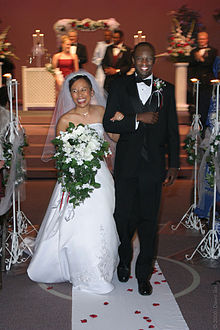
A 2004 California wedding betwixt a Filipina bride and a Nigerian groom.
Types [edit]
In that location are many means to categorize weddings, such as by the size or cultural traditions. A wedding may fall into several categories, such as a destination microwedding, or a civil elopement.
White wedding ceremony [edit]

A white wedding is a term for a traditional formal or semi-formal Western wedding. This term refers to the color of the wedding dress, which became popular subsequently Queen Victoria wore a pure white gown when she married Prince Albert and many were quick to copy her option.[ane] At the time, the color white symbolized both extravagance and virginal purity to many and had become the colour for utilize by young women existence formally presented to the imperial courtroom.[2]
Civil wedding [edit]
A civil wedding is a ceremony presided over by a local civil authority, such as an elected or appointed judge, Justice of the peace or the mayor of a locality. Civil wedding ceremonies may use references to God or a deity (except in U.M constabulary where readings and music are also restricted), merely generally no references to a particular religion or denomination.
Civil weddings allow partners of different faiths to marry without i partner converting to the other partner's religion.
They tin be either elaborate or simple. Many ceremonious nuptials ceremonies take place in local boondocks or urban center halls or courthouses in judges' chambers.
The relevance of civil weddings varies greatly from state to state. Some countries do non provide any form of civil wedding at all (Israel and many Islamic countries), while in others it is the only legally recognized grade of matrimony (most countries in Latin America, Europe, and Asia). In this case civil weddings are typically either a mandatory prerequisite for any religious ceremony or religious weddings have no legal significance at all. See Civil Marriage[46]
Destination wedding [edit]
Not to be dislocated with an elopement, a destination wedding ceremony is one in which a wedding is hosted, oft in a vacation-similar setting, at a location to which most of the invited guests must travel and oft stay for several days. This could exist a beach anniversary in the torrid zone, a lavish consequence in a metropolitan resort, or a uncomplicated ceremony at the home of a geographically distant friend or relative. During the recession of 2009, destination weddings connected to see growth compared to traditional weddings, as the typically smaller size results in lower costs.[47]
Weddings held at prestigious venues such as castles or stately homes take become increasingly pop in the 21st century particularly in European countries such as the UK, France and Deutschland. From 2010 onwards, there has been an increase in destination weddings that are hosted in exotic places like Republic of indonesia, Republic of the maldives, India, and Pakistan.
Destination weddings are prohibited in certain denominations of Christianity, such as the Catholic Church, which teach that Christian marriages should take place in the presence of God at church, where Christians began their journeying of faith in the sacrament of baptism.[22]
Double wedding ceremony [edit]
A double wedding is a double ceremony where two affianced couples rendezvous for two simultaneous or sequent weddings. Typically, a fiancé with a sibling who is also engaged, or four close friends in which both couples within the friendship are engaged might plan a double wedding where both couples legally ally.
Elopement [edit]
Elopement is the act of getting married, oftentimes unexpectedly, without inviting guests to the wedding. In some cases, a small-scale grouping of family or friends may be present, while in others, the engaged couple may ally without the consent or knowledge of parents or others. While the couple may or may not be widely known to exist engaged prior to the elopement, the wedding itself is generally a surprise to those who are later on informed of its occurrence.
Handfasting [edit]
A handfasting is an old infidel custom, dating back to the time of the ancient Celts. A handfasting was originally more like an appointment menstruum, where two people would declare a binding spousal relationship between themselves for a year and a day. The original handfasting was a trial marriage.[48]
Highland or Scottish wedding [edit]

The groom and i other in the nuptials political party wear a kilt with Argyll jacket and long tie.
A Highland or Scottish nuptials has the groom, with some or all of the groom's men clothing a kilt. The helpmate may habiliment a sash or other tartan clothing. The Scottish handbasket sword is used for whatsoever Saber Curvation.
Mass wedding [edit]
A collective or mass wedding is a single ceremony where numerous couples are married simultaneously.
Microwedding [edit]
A microwedding is defined by the small number of friends and family members present. The number of guests is usually understood to be no more than than 10 or xv people including family members,[49] although some sources will use this characterization for a small hymeneals with up to l guests.[50] Compared to an elopement or a ceremonious wedding with no guests, a microwedding is planned and appear in advance and may contain whatever traditions and activities the family wants to maintain, such equally a wedding block, photographs, or religious ceremonies.[49] Although the cost per invitee may be higher, the overall price of a microwedding is normally significantly less than a large wedding.[49] [51] Microweddings gained attending during the COVID-19 pandemic as a manner to have a wedding result in compliance with public health restrictions.[52] [53]
Armed services wedding [edit]

A war machine wedding ceremony is a ceremony conducted in a war machine chapel and may involve a Saber Curvation. In most armed forces weddings one or both of the people getting married volition vesture a military dress uniform in lieu of civilian formal article of clothing. Some retired military personnel who marry after their service has concluded may opt for a military wedding ceremony.
Peasant wedding [edit]
A peasant wedding is a Dutch funfair custom.
Non everywhere in Limburg and Brabant is a boerenbruiloft (peasant's wedding) part of the carnival. Especially in the northern and central part of Limburg and eastern part of N Brabant is the boerenbruiloft very often held during the funfair and is an important part of the carnival civilisation. Each carnival clan has its own tradition concerning choosing the spouse for a hymeneals. Often the bride and groom are chosen by the council of eleven or by the couple that was married the year before. It is non necessary that the newlyweds are a couple in real life. It is also not necessary that the helpmate and groom are unmarried. Both the helpmate and groom, however, should be in dearest during the carnival and they need to transfer their love to all the people who celebrate their hymeneals along with them. The highlight of the festival of the peasant wedding is the wedding ceremony and banquet of the onecht (not-marriage) of the bride and groom. There are many aspects that can be found in a existent-life wedlock. Kickoff the engagement volition be announced just equally if information technology would be an official matrimony. And both the families should learn to know each other very well in organizing the party and the anniversary, like a normal wedding ceremony. The two families set up a piece of amusement for the wedding ceremony.[54] And simply similar a existent wedding, a reception and a banquet is organized where guests are asked to wear appropriate clothing. The bride and groom will oftentimes dress in nuptials clothing from before 1940. The bride, for case, volition oftentimes wear a poffer, which is a traditional Brabantian headdress.[55]
Same-sexual activity wedding [edit]
A wedlock between two people of the same sex.
Shotgun wedding [edit]
A shotgun wedding is a wedding in which the groom is reluctant to ally the bride, however, is strongly encouraged to practise so to avert family, social or legal repercussions. In many cases, the helpmate is pregnant earlier the nuptials and the family unit of the bride, most commonly the helpmate's father insists that the groom ally the bride earlier the pregnancy becomes obvious.
Vow renewal wedding ceremony [edit]
A hymeneals vow renewal is a anniversary in which a married couple renews or reaffirms their nuptials vows. Typically, this ceremony is held to commemorate a milestone wedding ceremony ceremony. It may besides be held to recreate the union ceremony in the presence of family and friends, especially in the case of an before elopement.
Weekend hymeneals [edit]
A weekend wedding is a wedding in which couples and their guests gloat over the course of an entire weekend. Special activities, such as spa treatments and golf tournaments may be scheduled into the wedding itinerary. Lodging usually is at the same facility every bit the wedding and couples often host a Sunday brunch for the weekend's finale.
Hymeneals ceremony participants [edit]
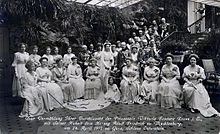
Formal family unit picture of a Purple Wedding ceremony.

Waiting for the bride. From left: priest, groom and ushers in New Zealand wearing Scottish kilts.

Hymeneals ceremony participants too referred to as the hymeneals party, are the people that participate straight in the hymeneals ceremony itself.
Depending on the location, religion, and style of the wedding, this grouping may include only the individual people that are marrying, or it may include one or more than brides, grooms (or bridegrooms), persons of honor, bridespersons, all-time persons, groomsmen, bloom girls, pages, and band bearers.
A "bride'southward political party" consists of those on her side, while a "groom's party" consists of those on his side.
- Bride: A woman about to be married.
- Bridegroom or Groom: A man about to exist married.
- Marriage officiant: The person who officiates at the wedding, validating the wedding from a legal and/or religious standpoint. This person may exist a estimate, justice of the peace, or a member of the clergy. In Hindu marriages, the marriage officiant is called a pandit or Brahmin.[56]
- Best Man, Woman, or Person: The master assistant to a benedict at a wedding, typically a sibling or friend of special significance in his life. Often holds the wedding rings until their exchange.
- Mothers of a Bride or Groom
- Fathers of a Bride or Groom
- Maid, Matron or Man of Honor: the title and position held by a helpmate's chief attendant, typically her closest friend or sibling.
- Bridesmaids: the female person attendants to a helpmate. Males in this role may exist called honor attendants or sometimes bridesmen, merely that term has a different traditional meaning.
- Groomsmen or Ushers: The attendants, usually male, to a bridegroom in a wedding anniversary. Female attendants, such as a sister of the groom, are typically called honour attendants.
- Pages: Young attendants may deport a helpmate's train. In a formal hymeneals, the ring bearer is a special page that carries the rings down the aisle. The coin bearer is a like page that marches on the wedding aisle to bring the nuptials coins.
- Flower girls: In some traditions, one or more children carry bouquets or drop flower petals in front of a bride in the wedding procession.
Wedding manufacture [edit]
The global nuptials manufacture was worth $300 billion as of 2016. The United States wedding industry alone was estimated to be worth $60 billion as of the same year. In the Us, the wedding manufacture employs over i million people throughout 600,000 businesses and grows 2% each year. The industry has undergone a transition due to the increased employ of technology. Bridal websites, blogs, and social media accounts have driven spending up and created new trends and traditions.[57]
In 2016 alone the average cost of a nuptials in the U.Due south. was estimated to exist at $35,329,[58] though the boilerplate American spent around $14,399[59] that year. According to one scholarly written report of American couples, extravagant spending on weddings is associated with debt stress and short-lived marriages that end in divorce.[60] Couples who spent less than US$10,000 on all nuptials-related expenses, and who had a relatively large number of guests in attendance, were the to the lowest degree likely to divorce.[sixty]
See also [edit]
- Wedding customs by country
- White wedding ceremony
- Wedding wearing apparel
- Wedding reception
- Wedding cake
- Elopement
References [edit]
- ^ a b "Why Do Brides Wear White?". britannica.com . Retrieved September 7, 2021.
- ^ a b Otnes, Cele & Pleck, Elizabeth (2003). Cinderella Dreams: the Attraction of the Lavish Nuptials, p. 31. Academy of California Press, Berkeley.
- ^ Howard, Vicky (2006). Brides Inc.: American Weddings and the Business of Tradition, p. 34. University of Pennsylvania Printing, Philadelphia.
- ^ a b Howard, Vicky (2006). Brides Inc.: American Weddings and the Business organisation of Tradition, p. 61. University of Pennsylvania Printing, Philadelphia.
- ^ a b B Singh (2013). "Marketing strategies of rice exporters" (PDF).
- ^ Xu, Guobin; Chen, Yanhui; Xu, Lianhua (2018). "Western Folklore". Introduction to Western Culture. pp. 163–187. doi:ten.1007/978-981-10-8153-8_6. ISBN978-981-10-8152-1.
- ^ Abd. Razak Aziz, Awang Azaman Awang Pawi (December 1, 2016). "Redefining Malay Food in the Postal service Malaysia's New Economical Policy (NEP)" (PDF). Journal of Tourism, Hospitality & Culinary Arts (JTHCA). 8 (two).
- ^ "Fact or Fiction: Uncooked Rice is Bad for Birds". American Chemical Guild. November 5, 2018.
- ^ United kingdom), Folklore Club (Great (1895). Publications.
- ^ [1] Archived August 14, 2012, at the Wayback Motorcar
- ^ "Kilts: tightly woven into Scots culture". Scotsman. February 10, 2005. Archived from the original on February 2, 2007. Retrieved April sixteen, 2007.
- ^ "The Scottish Kilt". Visit Scotland. Retrieved April sixteen, 2007.
- ^ Jim Murdoch. "Scottish Culture and Heritage: The Kilt". Scotsmart. Retrieved Apr 16, 2007.
- ^ "Marriage of Mr A.One thousand. Finlay and Miss Robinson". The Queanbeyan Age. NSW. Baronial 14, 1878. p. 1. Retrieved September 4, 2013.
- ^ Cooke, Deryck Five. "Richard Wagner | German language composer". Britannica.com . Retrieved Nov 10, 2015.
- ^ Pollack, Suzanne (September 25, 2015) "No Wagner for You", Washington Jewish Calendar week. Retrieved December 26, 2019.
- ^ "England and Wales", Music Not Allowed at Civil Ceremonies (article), Wedding Music Designer (Simon Jordan), Baronial xxx, 2015
- ^ Hassall, Jill (2012). "Catechism+in+D+by+Pachelbel"&pg=PA53 The Greatest Guide to Your Dream Wedding. Greatest Guides. p. 53. ISBN9781907906060 . Retrieved Nov 20, 2017.
- ^ Tiffany, Kaitlyn (March 1, 2019). "Why is the nuptials industry so hard to disrupt?". Vocalization . Retrieved March 4, 2019.
- ^ Smith, Peter (2000). "Marriage". A concise encyclopedia of the Bahá'í Faith. Oxford: Oneworld Publications. pp. 232–233. ISBN1-85168-184-1.
- ^ a b The Subject of the Allegheny Wesleyan Methodist Connectedness (Original Allegheny Briefing). Salem: Allegheny Wesleyan Methodist Connection. 2014. p. 21.
- ^ a b c d e Dooley, Sandra (June 20, 2016). A Guide to Catholic Weddings. Liturgy Training Publications. pp. 29–xxx. ISBN978-1-61833-134-2.
- ^ "Wedding arrangements". June 23, 2008. Archived from the original on December 16, 2008. Retrieved Nov ten, 2015.
- ^ Dipippo, Gregory (Feb eight, 2019). "The Velatio Nuptialis: An Ancient (and Forgotten) Part of the Latin Wedlock Rite". Novus Motus Liturgicus. Retrieved January 23, 2022.
- ^ Olavus Petri (1929). The Evangelical Lutheran Church Manual of Olavus Petri: A Transmission in Swedish, Including Baptism, Etc. Lutheran Augustana Book Concern.
- ^ Hopkins, Samuel Miles (1883). General Liturgy and Volume of Common Prayer. A.S. Barnes. p. 135.
- ^ Monger, George (2004). Wedlock Customs of the World: From Henna to Honeymoons. ABC-CLIO. p. 53. ISBN978-1-57607-987-4.
- ^ Warner, Diane (November 25, 2013). Diane Warner'due south Consummate Guide to a Traditional Wedding ceremony: Time-Tested Toasts, Vows, Ceremonies & Etiquette: Everything Yous Demand to Create Your Perfect Twenty-four hour period. Cherry Wheel. ISBN978-1-60163-494-eight.
- ^ The Book of Worship for Church building and Home: With Orders of Worship, Services for the Administration of the Sacraments and Other Aids to Worship Co-ordinate to the Usages of the Methodist Church. Methodist Publishing House. 1964. p. 32. Retrieved March 25, 2017.
- ^ Tucker, Karen B. Westerfield (April 27, 2011). American Methodist Worship. Oxford University Press. p. 188. ISBN9780190454203.
- ^ "A Service of Christian Marriage". Discipleship Ministries. 1992. Retrieved March 28, 2017.
- ^ The Alternative Wedding Book. Woods Lake Publishing Inc. 1995. p. forty. ISBN978-1-55145-081-0.
- ^ "Guide to the Jewish Hymeneals". Retrieved July 3, 2008.
- ^ "Nissuin: The Second of the Ii Ceremonies". Retrieved July iii, 2008.
- ^ "Understanding the Jewish Wedding". Archived from the original on September 21, 2007. Retrieved July 3, 2008.
- ^ "Ceremony: Jewish Nuptials Rituals". Retrieved July 3, 2008.
- ^ "Marriage in Jewish Art". Retrieved July 3, 2008.
- ^ Dodge, Christine Huda. "Islamic Wedding Party Community". About.com. Retrieved June 8, 2013.
- ^ "Religions – Islam: Weddings". BBC. Retrieved November x, 2015.
- ^ Siu, Tyrone. "Chicken ceremony rooted in aboriginal rites". Retrieved July 8, 2018.
- ^ "Humanist Society Scotland | Celebrate the one life we have". Humanism-scotland.org.u.k.. August 28, 2015. Retrieved November 10, 2015.
- ^ "Scottish humanists to overtake Kirk weddings". BBC Scotland. June 18, 2015. Retrieved May 31, 2017.
- ^ Brocklehurst, Steven (August 2016). "More than 4200 Humanist weddings took identify in Scotland concluding year". Humanist Guild Scotland . Retrieved May 31, 2017.
- ^ Walsh, Fionnuala (Apr 11, 2019). "Less than half of Irish weddings are Cosmic". The Times. Archived from the original on April xviii, 2019. Retrieved May 22, 2019.
- ^ "Success! Couple win challenge to lack of legal recognition of humanist marriages in Northern Ireland". Humanists Britain. June 9, 2017. Retrieved June ix, 2017.
- ^ for details. Gavira, Juan. "Characteristics of a Spanish nuptials" Archived March 3, 2016, at the Wayback Machine. Juangavira.com
- ^ Parsons, Claudia (May 12, 2009). "Destination weddings run into growth despite recession". Reuters . Retrieved Nov x, 2015.
- ^ "Nigh Handfastings". Handfastings.org. Retrieved November 10, 2015.
- ^ a b c Goldfarb, Anna (October 12, 2017). "What to Know Nigh Having a Microwedding". The New York Times. ISSN 0362-4331. Retrieved Jan 17, 2021.
- ^ Mackey, Jaimie (April xv, 2020). "What Is a Micro Wedding and Should You Have 1?". Brides . Retrieved January 17, 2021.
- ^ Midland, Cary (October 8, 2018). "What'due south a Micro Nuptials, and Why Are They Condign So Popular?". Martha Stewart . Retrieved January 17, 2021.
- ^ Velez, Mandy (July 6, 2020). "COVID-19 Didn't Kill Weddings. But It May Modify Them Forever". The Daily Brute . Retrieved January 17, 2021.
- ^ Rello, Gabriella (July 13, 2020). "How to Plan a Beautiful, Meaningful Micro Wedding So That You Tin Gloat Your Postponed Wedding Right At present". Martha Stewart . Retrieved Jan 17, 2021.
- ^ "Wedding Day Invitation Styles and Designs – A Vintage Arroyo". Houseplantation. Dec 10, 2015. Archived from the original on January 21, 2016. Retrieved Baronial 26, 2016.
- ^ "Boerenbruiloft: hoezo in het 'onecht' verbonden? | Vastelaovend en Carnaval in Limburg". Vastelaovendinlimburg.nl. April eight, 2013. Retrieved October 29, 2013.
- ^ Britannica, The Editors of Encyclopaedia (Feb 23, 2021). "Brahman". Encyclopedia Britannica . Retrieved January 21, 2022.
- ^ "Function 1: The Past, Present and Time to come of the Hymeneals Industry". HuffPost. Feb 24, 2016.
- ^ Lui, Kevin. "This Is How Much It Now Costs to Get Married in the U.S. on Average". Fortune . Retrieved June 30, 2017.
- ^ 2016 U.S. Median Cost of a Nuptials was $xiv,399, The Hymeneals Institute, retrieved September 1, 2017
- ^ a b Francis-Tan, Andrew; Mialon, Hugo M. (September fifteen, 2014). "'A Diamond is Forever' and Other Fairy Tales: The Human relationship between Wedding Expenses and Spousal relationship Elapsing". Rochester, NY. doi:10.2139/ssrn.2501480. S2CID 44741655. SSRN 2501480.
External links [edit]
-
 The dictionary definition of wedding at Wiktionary
The dictionary definition of wedding at Wiktionary
Source: https://en.wikipedia.org/wiki/Wedding


0 Response to "How Much Should a Family of 3 Give to a Second Wedding"
Post a Comment